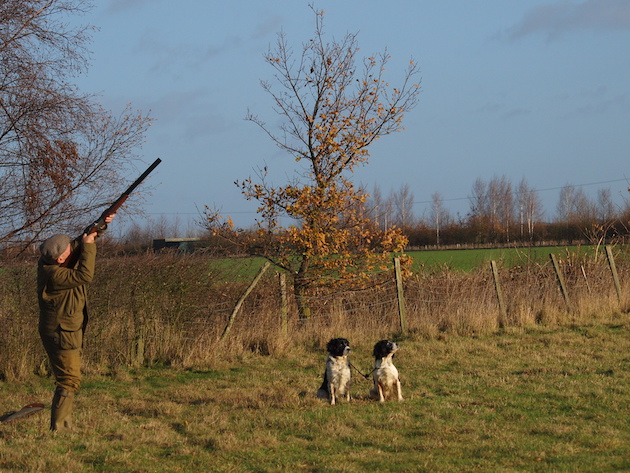How far does a shotgun pellet travel? A shotgun pellet can travel up to 800 yards (730 meters), but the shotgun pellet range for effectiveness is much shorter. This article will explore the maximum shotgun range, effective shotgun range, factors influencing shotgun pellet distance, and critical safety aspects of shotgun pellet travel distance.

Image Source: www.shootinguk.co.uk
Fathoming Shotgun Pellet Ballistics
Shotgun pellet ballistics are complex, affected by numerous variables. Key factors determining how far a pellet travels include:
- Pellet size and type
- Shotgun gauge
- Shell load
- Barrel length
- Environmental conditions
Pellet Size and Type
Different pellet sizes and materials have varying ballistic coefficients, affecting their ability to overcome air resistance. Larger pellets retain velocity better and travel farther than smaller pellets. Lead, steel, and other alloys each have different densities influencing shotgun pellet velocity distance.
Shotgun Gauge
The gauge of a shotgun (e.g., 12 gauge, 20 gauge) impacts the amount of shot that can be loaded into a shell. A 12 gauge usually holds more shot and can therefore deliver more pellets at a greater shotgun pellet range than a smaller gauge.
Shell Load
Shell load refers to the amount of shot (pellets) contained within a shotshell. Higher loads generally mean more pellets are propelled, potentially increasing the chance of hitting a target at a moderate shotgun pellet distance, but not necessarily increasing the maximum range.
Barrel Length
While barrel length affects muzzle velocity to some extent, it’s less influential on maximum range than pellet size and type. Longer barrels can provide slightly higher velocities, but the difference is often minimal.
Environmental Conditions
Wind, temperature, and altitude all play a role. Wind can significantly deflect pellets, while temperature and altitude affect air density, which in turn impacts drag.
Deciphering Maximum Shotgun Range
The maximum shotgun range refers to the furthest distance a pellet can travel, regardless of its effectiveness. This distance is primarily of concern for safety. Remember, even at extreme ranges, a pellet retains enough energy to cause injury.
- 12 gauge range: A 12-gauge shotgun, with typical birdshot, can send pellets flying up to 800 yards (730 meters).
- Smaller gauges: Smaller gauges, like 20 gauge or .410 bore, generally have shorter maximum ranges due to lighter pellet loads.
It’s vital to be aware of what lies beyond your target, as pellets can travel a considerable distance and potentially strike unintended targets.
Interpreting Effective Shotgun Range
Effective shotgun range is the distance at which a shotgun can reliably deliver enough pellets to a target to cause the desired effect. This range is significantly shorter than the maximum range. This range depends on the size of the target, the pattern, the size of shot, and the desired effect.
Birdshot
Birdshot (small pellets used for birds) has a relatively short effective shotgun range, generally 25 to 40 yards (23 to 37 meters). Beyond this distance, the shotgun pellet spread distance becomes too wide, and individual pellets lack the energy to reliably incapacitate a bird.
Buckshot
Buckshot (larger pellets used for deer or self-defense) has a longer effective shotgun range than birdshot, typically 40 to 60 yards (37 to 55 meters). However, shotgun pellet spread distance is still a factor, and at longer ranges, the pattern may become too sparse to ensure a hit.
Slugs
Slugs (single projectiles) have the longest effective shotgun range of all shotgun ammunition types, potentially reaching 100 to 150 yards (91 to 137 meters) or more, depending on the specific slug and firearm. They offer significantly improved accuracy and retained energy at longer distances compared to shot.
Analyzing Shotgun Pellet Spread
Shotgun pellet spread distance refers to the widening pattern of pellets as they travel downrange. This spread is influenced by several factors:
- Choke: The choke of a shotgun barrel constricts the shot pattern. Tighter chokes (e.g., full choke) produce denser patterns at longer ranges, while more open chokes (e.g., cylinder bore) result in wider patterns at shorter ranges.
- Shell Construction: Some shells are designed with features to tighten patterns, such as shot cups or buffering materials.
- Distance: Naturally, the further the shotgun pellet distance, the wider the spread.
Table: Choke and Approximate Pattern Diameter at 40 Yards
| Choke | Pattern Diameter (Inches) |
|---|---|
| Cylinder | 40-50 |
| Improved Cylinder | 30-40 |
| Modified | 25-35 |
| Full | 20-30 |
It’s crucial to pattern your shotgun with different loads to determine the shotgun pellet spread distance at various ranges. This will help you determine the effective shotgun range for your specific firearm and ammunition.
Assessing How Far Can Shotgun Pellets Kill
How far can shotgun pellets kill? While pellets may travel hundreds of yards, the lethal range is far less. The energy of a pellet decreases rapidly with distance due to air resistance. While a pellet might penetrate skin at extreme ranges, the likelihood of causing a fatal wound diminishes significantly beyond the effective shotgun range.
- Birdshot: Unlikely to cause fatal injuries beyond 40 yards (37 meters).
- Buckshot: Can cause serious injuries or fatalities out to 60 yards (55 meters), but effectiveness decreases significantly beyond that point.
- Slugs: Capable of lethal force out to 150 yards (137 meters) or more.
It’s paramount to recognize that even non-lethal injuries can still be serious. Always prioritize safety and responsible gun handling.
Grasping Safety Considerations
Safety is paramount when handling shotguns. Always adhere to the following safety rules:
- Treat every firearm as if it is loaded.
- Never point a firearm at anything you are not willing to destroy.
- Keep your finger off the trigger until you are ready to shoot.
- Be sure of your target and what is beyond it.
Specific Shotgun Safety Considerations
- Know your shotgun’s maximum range: Be aware of the potential distance your pellets can travel.
- Identify your target and beyond: Ensure a safe backstop and be certain of what lies beyond your target. Pellets can travel far and potentially injure unintended targets.
- Use appropriate ammunition: Select the correct ammunition for your shotgun and the intended purpose.
- Wear appropriate safety gear: Eye and ear protection are essential when shooting.
- Store firearms securely: Keep firearms locked and unloaded when not in use, and store ammunition separately.
FAQs: Shotgun Pellet Range
- What is the maximum range of a 12-gauge shotgun? A 12-gauge shotgun can send pellets flying up to 800 yards (730 meters).
- What is the effective range of buckshot? The effective range of buckshot is typically 40 to 60 yards (37 to 55 meters).
- Can I use birdshot for self-defense? While birdshot can cause injury at close range, it is not generally recommended for self-defense due to its limited penetration and effectiveness compared to buckshot or slugs.
- Who is responsible for pellet strikes beyond the target? The shooter is always responsible for where their pellets travel.
- What is the best choke for buckshot? The best choke for buckshot depends on your specific shotgun and load. It’s recommended to pattern your shotgun with different chokes to determine which provides the tightest and most consistent pattern at your desired range.
- How does temperature affect shotgun pellet range? Higher temperatures generally result in lower air density, which can slightly increase pellet range due to reduced drag.
- What’s the ideal shotgun pellet velocity distance? The ideal velocity depends on the intended target. You want enough velocity to ensure sufficient penetration, but excessive velocity can sometimes lead to pattern disruption. Consult ballistic charts and manufacturer recommendations for specific ammunition.
- Is steel shot more dangerous in terms of range compared to lead shot? Steel shot tends to retain less energy downrange compared to lead, potentially reducing the maximum range, but it’s still crucial to be aware of the potential distance it can travel and practice safe shooting habits.
- What external factors most influence the shotgun pellet range? Wind and air resistance are primary external factors influencing the shotgun pellet range.
- How can I accurately assess the effective range of my shotgun? Patterning your shotgun with your chosen ammunition at different distances is the most accurate way to determine its effective range.
In Conclusion
Determining the shotgun pellet range requires considering numerous factors. While the maximum shotgun range can be considerable, the effective shotgun range is much shorter. Responsible gun ownership demands awareness of these distances, safe gun handling, and a thorough Interpreting of the potential consequences of every shot.

Hi, I’m Candace Wafford, a travel and food blogger based in Lexington, Kentucky. As a corporate traveler, I’ve had the chance to explore a lot of places, but now I’m on a mission to travel full-time. My goal? To figure out how to take my cat along for the adventure! Here at destinationdorworth.com, I share my experiences and tips on outdoor activities, travel, and of course, the best food spots I come across. I hope my blog inspires you to explore more and eat well on your journeys!
